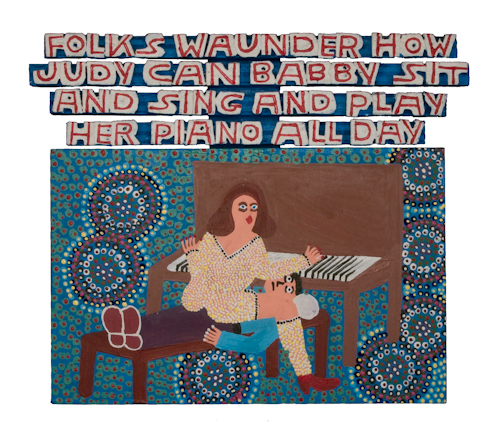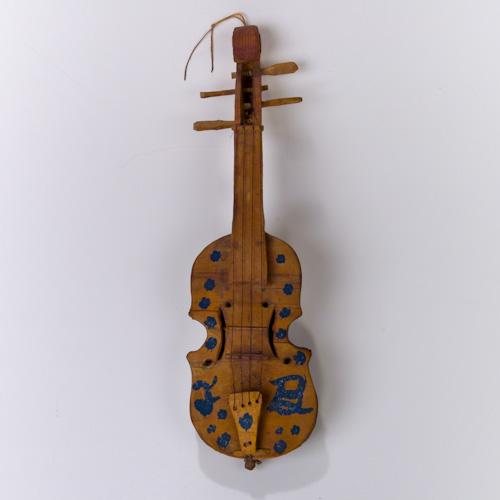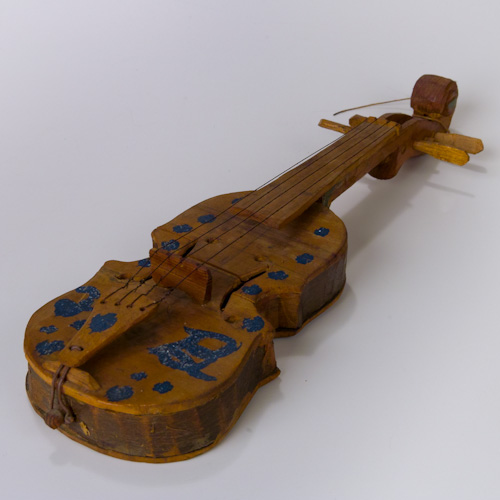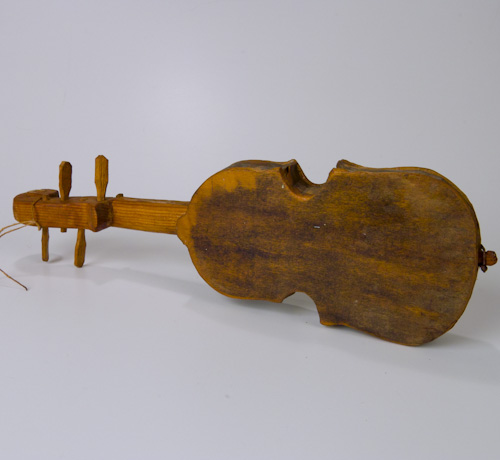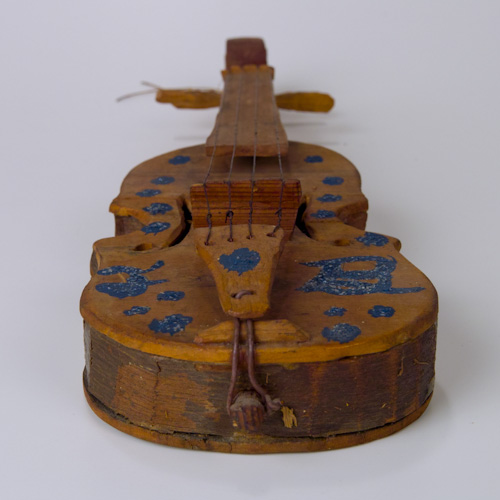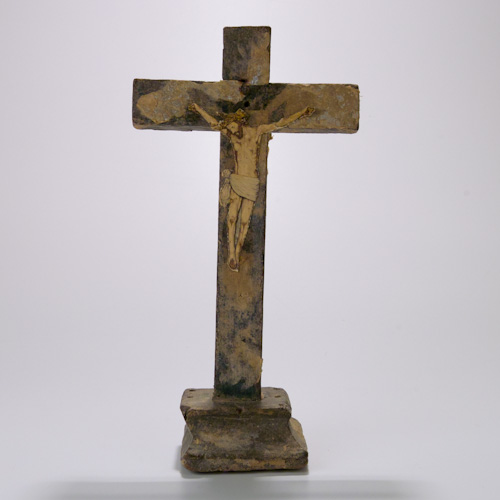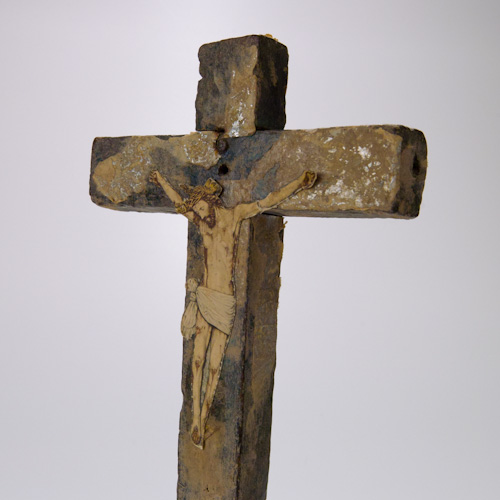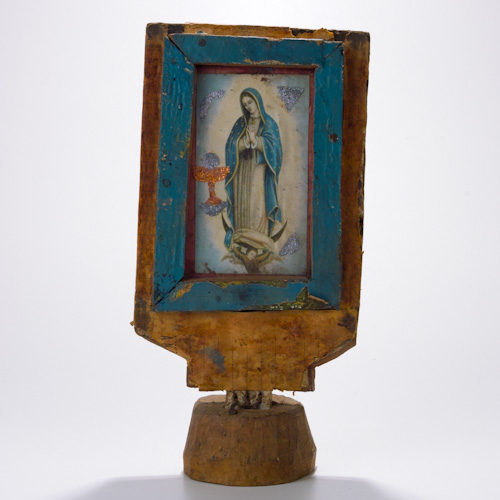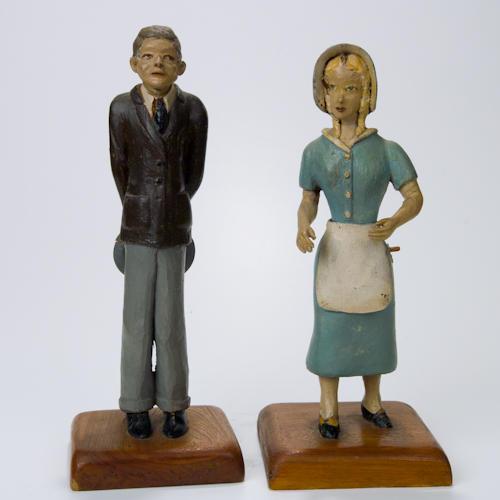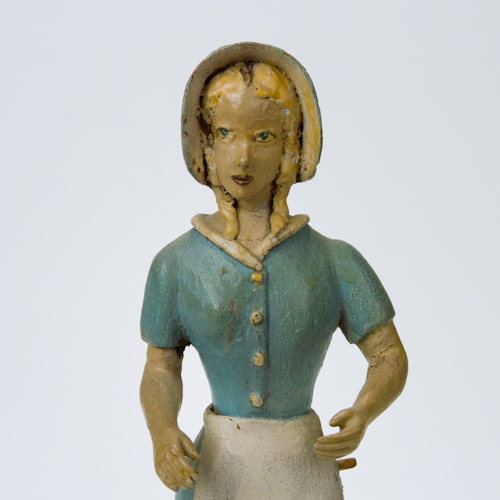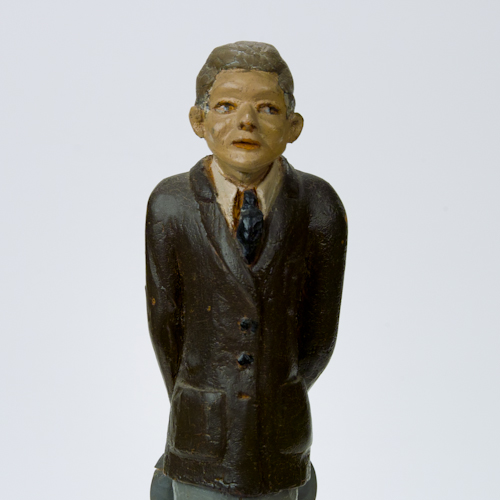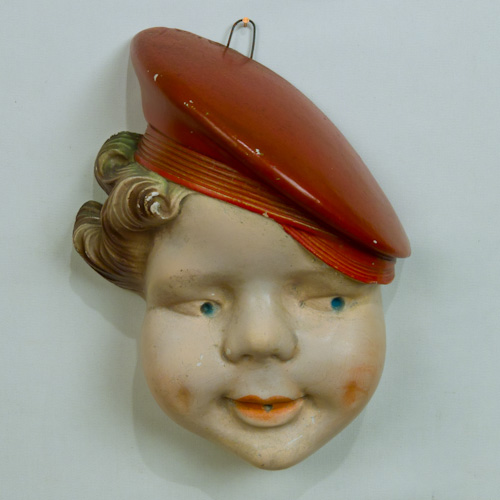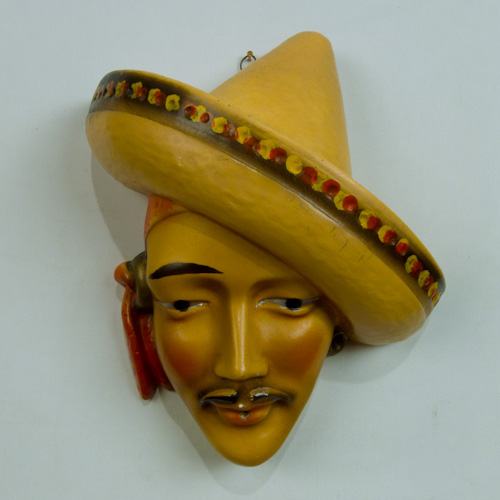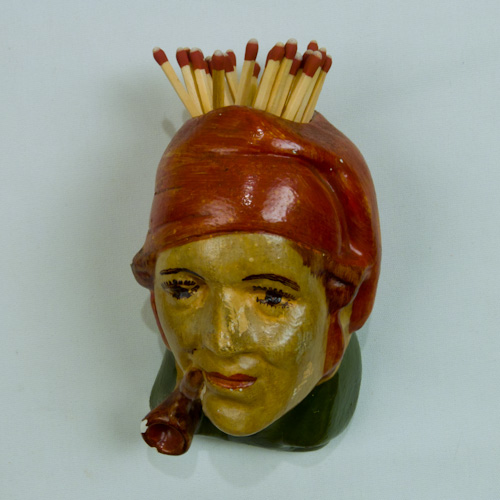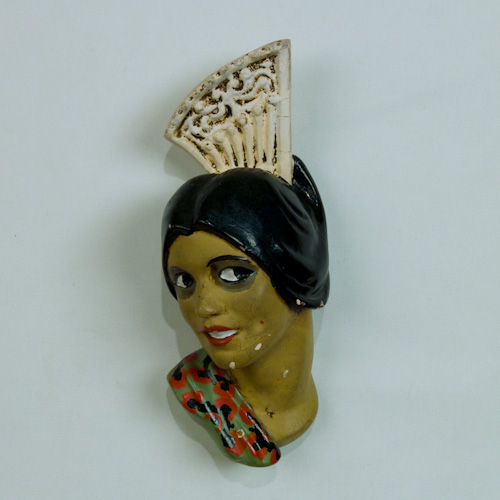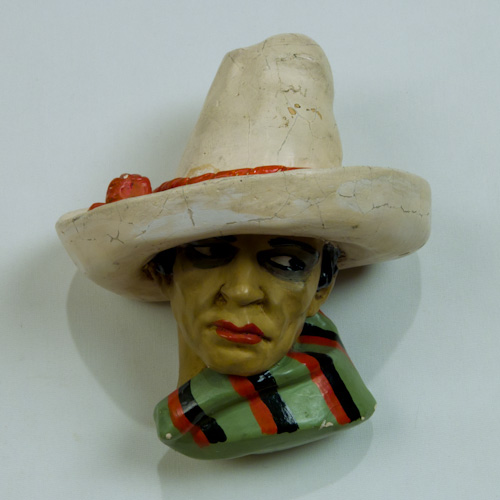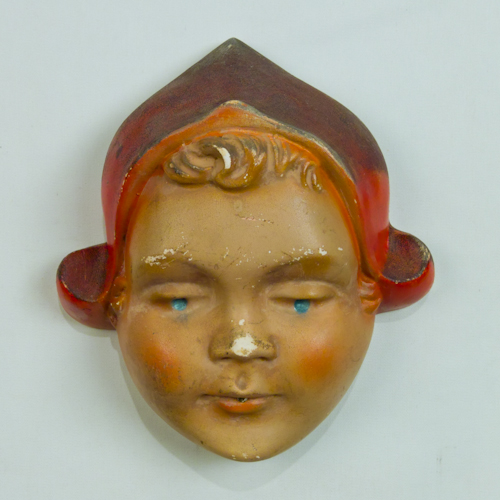Self Taught, Outsider, and Folk Art” by Betty-Carol Sellen describes James Harold Jennings as having been raised and “lived with his mother, a school teacher, until she died in 1974.” Jennings works ranged from bird houses, ferris wheels, angels; all colorful constructions. He used graphic symbols some target like, resembling pointillism, often included verbiage which added luminous humor to the assemblages. His “Tufgh” women beating up on men were frequent subjects for his apparently bawdy sense of humor.
Tag: folk art
Appalachian Folk Art Miniature Joe Byrnside Violin Fiddle
We discovered this sensitively made miniature violin at an antique “mall” east of Huntington, West Virginia in the middle 1980s. It was documented as being made by Joe Byrnside in Boone County, West Virginia, circa 1940s.
It is made of bent and carved wood, with decorative paint illustrating the maker’s signature J and B. The delicate metal “strings” are attached to the tail piece traveling over the bridge, up the neck and tightened over the tuning pegs. It also has F holes and a lovely scroll on which a short piece of old string, perhaps for hanging, is attached. The skill set shown indicates a true understanding of both the musical instrument as well as its construction. It is in excellent condition, all original to the maker’s vision and hand.
Measurements: approximately 12″ long x 3.5″ wide x 1.5″ tall
Kentucky Folk Artist Jim Lewis Mermaid Carved Sculptures
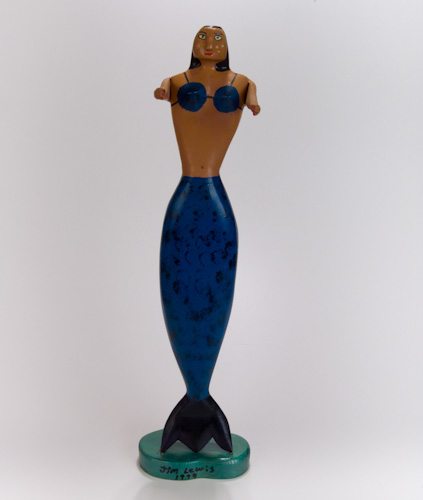
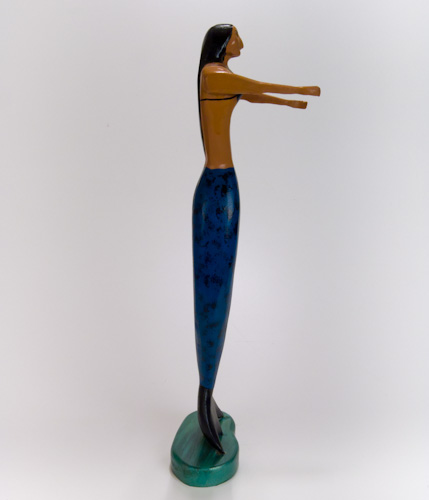
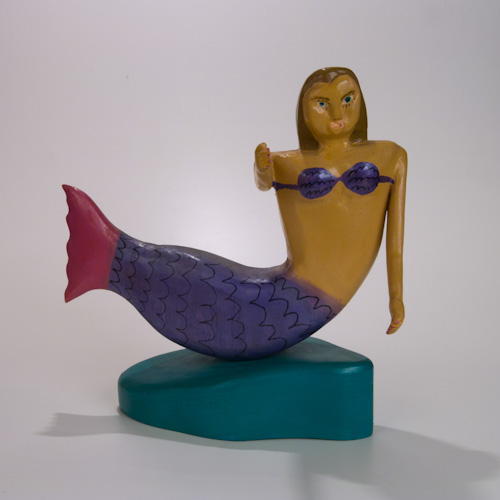
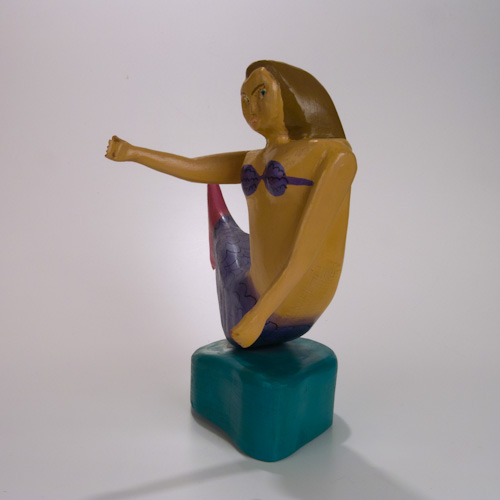
One of an extended family of well known, and collected folk art carvers from rural Kentucky, Jim Lewis joined his brothers and cousins, including Junior Lewis and Tim Lewis. The work of Minnie Adkins, and the late Garland Adkins, highly regarded regional folk artists, inspired Jim Lewis to begin carving. He had worked as a heavy equipment operator before working exclusively on his art, working in basswood, as well as maple for his canes. We attended events including the sorghum festival and the annual “Day in the Country.” We purchased several of Jim Lewis’s canes and other sculptural work, including this early mermaid. Collectors of this genre of work recognize the importance of seminal work such as this mermaid. Early work, we feel is most inspired, most original. These pieces are signed and dated 1993 and 1994. His more recent work is sold at regional galleries. His work has been displayed ” nationally and internationally” including the Museum of American Folk Art and is sometimes available at the gallery at the Kentucky Folk Art Center in Morehead, Kentucky.
Vintage Carved Wood Mexican Religious Folk Art Cross Crucifix
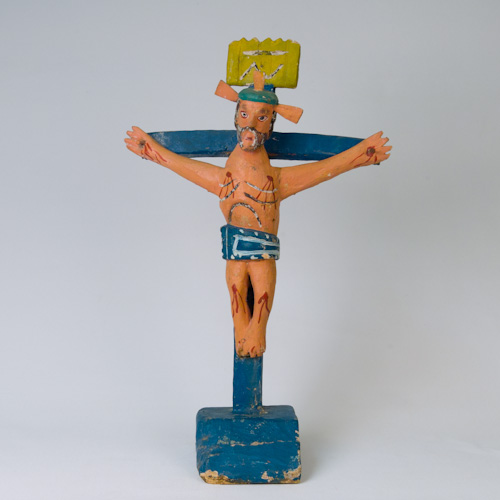
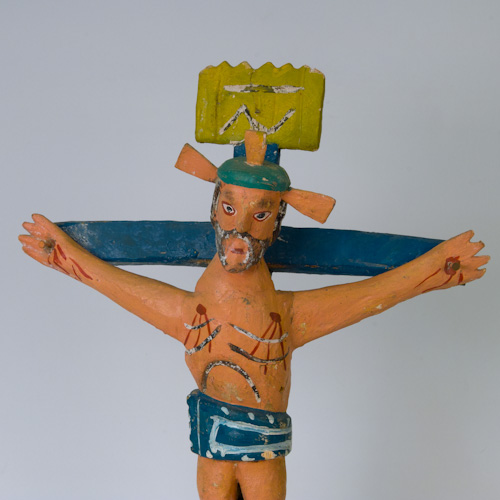
Our collection contains dozens of old vintage Mexican masks and other ethnographic art mostly from Guerrero, Mexico. Many of the masks and other ethnographic artifacts were purchased at the Ohio Ethnographic gallery in Columbus, Ohio, in the 1988, curiously; known for the selectivity of the work they showed and offered. This vintage wood crucifix has the original lime based paint and nails, some paint has worn away with age. It has a hairline crack in the green decorative piece, as depicted. Otherwise, it is a beautiful old example of the carving style of this geographical area of Mexico. Cheaper, more recent work from Guerrero, and Oaxaca, and Michoaca may be available elsewhere however, the tourist industry is resulting in production methods and stylization diminishing both the overall quality including character and value.
Measurements: 24″ x 15″ x 8″
Antique Handmade Cross Assemblage from Ecuador
We purchased this beautiful cross at an antique dealer’s booth in Cincinnati in the middle 80s. It appears to be an old wooden cross that was repurposed for a handmade crucifix assemblage. The dealer purchased it while in Ecuador years before our purchase. The assemblage is quite unique. The original cross and base are very old, wooden. There appears to be a previous coating of a silvery metallic guilding. Much, but not all of this is worn away revealing much of the wood. Someone, prior to the dealer’s purchase, applied a paper image of Christ on the cross to the front of the cross. This is the condition it was in at the time of its discovery at the antique mall in Cincinnati. There is an old nail driven through the bottom of the base which adjoins the cross. The assemblage and its lovely patina make this an especially interesting cultural and historical relic.
Measurements: 9″ x 4.5″ x 3″ (Base 2.75″ x 3″)
Vintage Virgin of Guadalupe Handmade Assembled Religious Artifact from Ecuador
We purchased this beautiful artifact at an antique dealer’s booth in Cincinnati in the middle 80s. It is a handmade assemblage the dealer purchased while in Ecuador years before its sale. As an assemblage, each element carries special meaning and spirit. The back comprised of wood contains some tiny holes inhabited, long ago, by some burrowing insect. There is also a bent nail from which it was probably originally hung on a wall; from which a raffia-like cord is strung, perhaps for a later use? The base is the means by which we have displayed it for, now, decades. The front of the wood is wrapped with a very old piece of paper on which it is printed “PULIVITIN” ? The Virgin, behind glass, is a printed piece on which the maker has applied several reflective cutout shapes.The frame is painted the same color as the VIrgin’s robe. There is an old nail which juts out from base as an anchoring device. It exudes such adoration, it conveys significant cultural and historical interest.
Measurements: 9.5″ x 4.5″ x 1″ (Base 2.5″ deep)
Vintage Carved and Painted Figures of a Man and Woman
We discovered this wonderful pair of figures at the Heartland Antique Show in Richmond, Indiana in the middle 1990s. They had been brought to this nationally recognized show by a antique dealer from Iowa. She did not know the figures provenance but said she believed them to be from the late 30s to early 40s. They are delicate and beautifully carved with great skill exhibited in technique. The attire is well articulated, the man holds a hat behind his back. The hat must have been broken at some stage as it had been carefully glued together at the time of our purchase. The woman’s shoes have some loss of the black paint. She is also missing what we believe must have been a basket which rested upon her left hip. There is a small peg which juts from her hip, some absence of paint makes it apparent something had been applied and then painted. Her flaxen hair and some of her facial features have been sculpted from a composite material. Perhaps glue and sawdust? Both the male and female figure stand on their original stained bases, each approximately 4″ x 4.5″ x .5″ tall. The figures each stand approximately 10″ tall on their bases. Scribed in pencil on the bottom of the male figure’s base is “Seale,” nothing further was discovered about their origin.
Chalkware
Although chalkware is a generic term for the material from which the decorative objects and accessories were made, they are actual made from plaster of Paris. Chalkware first appeared in the U.S. late in the 18th century. Popularized between the 1920s and 1940s, it was viewed as a cheaper alternative to more expensive ceramics and porcelain, chalkware enabled average consumers to purchase affordable copies. The pieces were created by first pouring plaster in to negative or cavity molds. After the plaster was hardened, the mold was removed and the chalky white unfinished piece was then painted by an employed finish “artist” with watercolors or enamel paints. The paint was another characteristic that distinguishes pricier ceramics with applied glazes from the painted chalkware alternative. Piggy banks, wall plaques, statues, smaller figurines, match holders, as well as highly collectible “string heads” were stylistically designed to add to their unique charm. Because of the nature of mold casts and the skill of the individual decorators or finish artists, each piece was idiosyncratic. Some chalkware is known as carnival chalkware, many pieces from this genre were based on characters and icons from popular culture of the times. Some pieces were meant as shelf or cabinet curios, while larger pieces could be displayed on the floor.
The pieces known by collectors as string heads, wall plaques, and wall pockets were always hung on walls. String heads were most often molded in the shape of a human head, their characters may have been based on real or fictional people, or in some cases storybook characters. While they were being made, a wire loop was partially embedded in the back of the plaster. String heads were indispensable prior to tape for securing packages. One would wrap the package in paper and conveniently dispense, cut sections, and knot the string or cord from the string head mounted on the wall. Regardless of their ornamental appeal, the demands of use, particularly true of string heads, meant the piece was frequently removed from the wall to replace the ball of string. Because plaster is inherently fragile, many examples of this type of popular commercial product, now appreciated as a form of folk art, were broken or chipped, showing distinct signs of wear during their use and often discarded.
Our collection of string heads and other chalkware is figural as is most of our folk art collection. The pieces were discovered at flea markets, antique stores and shows, during our travels in the mid 1980s. These, among others, are displayed as a group in the kitchen of our loft studio, guest always congregate in the kitchen and the string heads are always conversation pieces.
